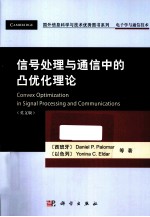

信号处理与通信中的凸优化理论 英文版PDF电子书下载
- 电子书积分:15 积分如何计算积分?
- 作 者:(西)帕洛马等著
- 出 版 社:北京:科学出版社
- 出版年份:2013
- ISBN:9787030354303
- 页数:498 页
1 Automatic code generation for real-time convex optimization&Jacob Mattingley and Stephen Boyd 1
1.1 Introduction 1
1.2 Solvers and specification languages 6
1.3 Examples 12
1.4 Algorithm considerations 22
1.5 Code generation 26
1.6 CVXMOD:a preliminary implementation 28
1.7 Numerical examples 29
1.8 Summary,conclusions,and implications 33
Acknowledgments 35
References 35
2 Gradient-based algorithms with applications to signal-recovery problems&Amir Beck and Marc Teboulle 42
2.1 Introduction 42
2.2 The general optimization model 43
2.3 Building gradient-based schemes 46
2.4 Convergence results for the proximal-gradient method 53
2.5 A fast proximal-gradient method 62
2.6 Algorithms for l1-based regularization problems 67
2.7 TV-based restoration problems 71
2.8 The source-localization problem 77
2.9 Bibliographic notes 83
References 85
3 Graphical models of autoregressive processes&Jitkomut Songsiri,Joachim Dahl,and Lieven Vandenberghe 89
3.1 Introduction 89
3.2 Autoregressive processes 92
3.3 Autoregressive graphical models 98
3.4 Numerical examples 104
3.5 Conclusion 113
Acknowledgments 114
References 114
4 SDP relaxation of homogeneous quadratic optimization:approximation bounds and applications&Zhi-Quan Luo and Tsung-Hui Chang 117
4.1 Introduction 117
4.2 Nonconvex QCQPs and SDP relaxation 118
4.3 SDP relaxation for separable homogeneous QCQPs 123
4.4 SDP relaxation for maximization homogeneous QCQPs 137
4.5 SDP relaxation for fractional QCQPs 143
4.6 More applications of SDP relaxation 156
4.7 Summary and discussion 161
Acknowledgments 162
References 162
5 Probabilistic analysis of semidefinite relaxation detectors for multiple-input,multiple-output systems&Anthony Man-Cho So and Yinyu Ye 166
5.1 Introduction 166
5.2 Problem formulation 169
5.3 Analysis of the SDR detector for the MPSK constellations 172
5.4 Extension to the QAM constellations 179
5.5 Concluding remarks 182
Acknowledgments 182
References 189
6 Semidefinite programming,matrix decomposition,and radar code design&Yongwei Huang,Antonio De Maio,and Shuzhong Zhang 192
6.1 Introduction and notation 192
6.2 Matrix rank-1 decomposition 194
6.3 Semidefinite programming 200
6.4 Quadratically constrained quadratic programming and its SDP relaxation 201
6.5 Polynomially solvable QCQP problems 203
6.6 The radar code-design problem 208
6.7 Performance measures for code design 211
6.8 Optimal code design 214
6.9 Performance analysis 218
6.10 Conclusions 223
References 226
7 Convex analysis for non-negative blind source separation with application in imaging&Wing-Kin Ma,Tsung-Han Chart,Chong-Yung Chi,and Yue Wang 229
7.1 Introduction 229
7.2 Problem statement 231
7.3 Review of some concepts in convex analysis 236
7.4 Non-negative,blind source-separation criterion via CAMNS 238
7.5 Systematic linear-programming method for CAMNS 245
7.6 Alternating volume-maximization heuristics for CAMNS 248
7.7 Numerical results 252
7.8 Summary and discussion 257
Acknowledgments 263
References 263
8 Optimization techniques in modern sampling theory&Tomer Michaeli and Yonina C.Eldar 266
8.1 Introduction 266
8.2 Notation and mathematical preliminaries 268
8.3 Sampling and reconstruction setup 270
8.4 Optimization methods 278
8.5 Subspace priors 280
8.6 Smoothness priors 290
8.7 Comparison of the various scenarios 300
8.8 Sampling with noise 302
8.9 Conclusions 310
Acknowledgments 311
References 311
9 Robust broadband adaptive beamforming using convex optimization&Michael Rübsamen,Amr EI-Keyi,Alex B.Gershman,and Thia Kirubarajan 315
9.1 Introduction 315
9.2 Background 317
9.3 Robust broadband beamformers 321
9.4 Simulations 330
9.5 Conclusions 337
Acknowledgments 337
References 337
10 Cooperative distributed multi-agent optimization&Angelia Nedi? and Asuman Ozdaglar 340
10.1 Introduction and motivation 340
10.2 Distributed-optimization methods using dual decomposition 343
10.3 Distributed-optimization methods using consensus algorithms 358
10.4 Extensions 372
10.5 Future work 378
10.6 Conclusions 380
10.7 Problems 381
References 384
11 Competitive optimization of cognitive radio MIMO systems via game theory&Gesualso Scutari,Daniel P.Palornar,and Sergio Barbarossa 387
11.1 Introduction and motivation 387
11.2 Strategic non-cooperative games:basic solution concepts and algorithms 393
11.3 Opportunistic communications over unlicensed bands 400
11.4 Opportunistic communications under individual-interference constraints 415
11.5 Opportunistic communications under global-interference constraints 431
11.6 Conclusions 438
Acknowledgments 439
References 439
12 Nash equilibria:the variational approach&Francisco Facchinei and Jong-Shi Pang 443
12.1 Introduction 443
12.2 The Nash-equilibrium problem 444
12.3 Existence theory 455
12.4 Uniqueness theory 466
12.5 Sensitivity analysis 472
12.6 Iterative algorithms 478
12.7 Acommunication game 483
Acknowledgments 490
References 491
Afterword 494
Index 495
- 《SQL与关系数据库理论》(美)戴特(C.J.Date) 2019
- 《联吡啶基钌光敏染料的结构与性能的理论研究》李明霞 2019
- 《情报学 服务国家安全与发展的现代情报理论》赵冰峰著 2018
- 《英汉翻译理论的多维阐释及应用剖析》常瑞娟著 2019
- 《新课标背景下英语教学理论与教学活动研究》应丽君 2018
- 《党员干部理论学习培训教材 理论热点问题党员干部学习辅导》(中国)胡磊 2018
- 《虚拟流域环境理论技术研究与应用》冶运涛蒋云钟梁犁丽曹引等编著 2019
- 《卓有成效的管理者 中英文双语版》(美)彼得·德鲁克许是祥译;那国毅审校 2019
- 《当代翻译美学的理论诠释与应用解读》宁建庚著 2019
- 《基于地质雷达信号波的土壤重金属污染探测方法研究》赵贵章 2019
- 《指向核心素养 北京十一学校名师教学设计 英语 七年级 上 配人教版》周志英总主编 2019
- 《《走近科学》精选丛书 中国UFO悬案调查》郭之文 2019
- 《北京生态环境保护》《北京环境保护丛书》编委会编著 2018
- 《中医骨伤科学》赵文海,张俐,温建民著 2017
- 《美国小学分级阅读 二级D 地球科学&物质科学》本书编委会 2016
- 《指向核心素养 北京十一学校名师教学设计 英语 九年级 上 配人教版》周志英总主编 2019
- 《强磁场下的基础科学问题》中国科学院编 2020
- 《小牛顿科学故事馆 进化论的故事》小牛顿科学教育公司编辑团队 2018
- 《小牛顿科学故事馆 医学的故事》小牛顿科学教育公司编辑团队 2018
- 《高等院校旅游专业系列教材 旅游企业岗位培训系列教材 新编北京导游英语》杨昆,鄢莉,谭明华 2019
